I’ll be honest: I wasn’t too excited by Guilds of Ravnica and Ravnica Allegiance. Now, don't get me wrong; I love the setting and personalities and lore of the ten guilds. However drafting felt simplistic, with little decision making due to the focus on guild identities. And the archetypes seemed a little bit too familiar to me: slightly refined versions of the Ravnica sets that had been released six years before.
So it's fair to say that I approached Murders at Karlov Manor with a fair amount of trepidation, fearing that Wizards of the Coast would just be traversing well-trodden paths. However, after looking at the cards in detail, I'm supremely pleased to say that the set feels very different and very new. Don't get me wrong; it embraces the setting and features multiple callbacks to the guilds and classic Ravnican mechanics. But the bulk of MKM really is quite unique. Let's take a look!
Mechanics and Themes
Disguise


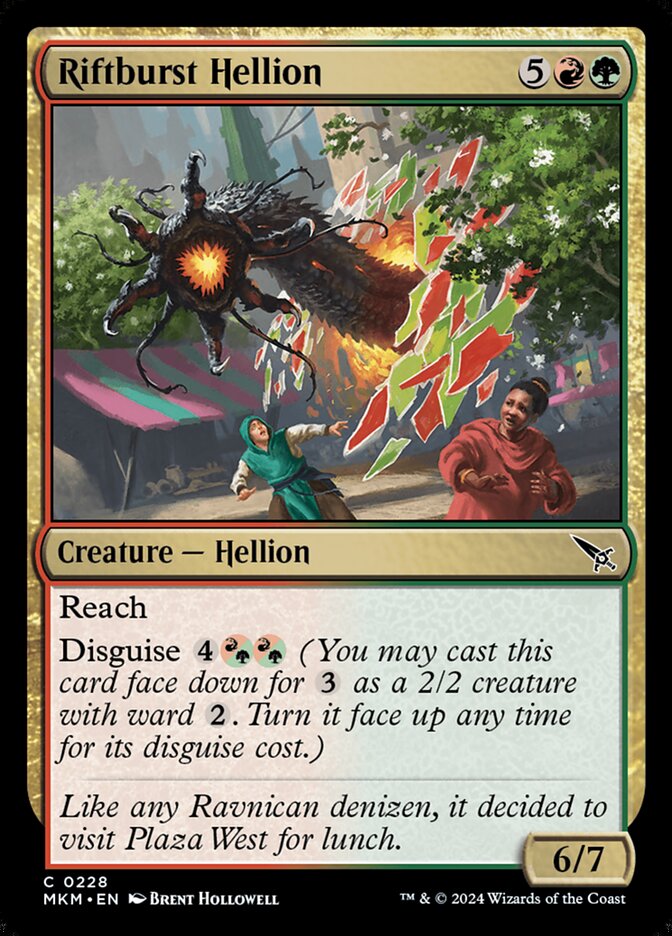
A murder mystery often involves questionable personages lurking in shadows, and MKM leans into this trope with the Disguise mechanic. A creature with Disguise can be cast face down for three mana as a 2/2 with Ward 2. They can then be turned face up at any time for its Disguise cost. This action cannot be responded to, and does not count as a permanent leaving or entering the battlefield; the creature simply, suddenly, and surprisingly stands revealed in its new form. Many Disguise creatures are similar to Forum Familiar and have an added effect when they are flipped up. Others provide flexibility with their mana costs: Riftburst Hellion may have a Red/Green mana cost, but it can be flipped up by any deck that plays Red or Green.
There are a few additional rules to keep in mind with Disguise cards:
Cards with Disguise follow the five mana Morph rule established in Khans of Tarkir: it will always cost at least five mana for a face down Disguise creature to flip into a creature with toughness 3 or greater. This rule is very helpful in avoiding unexpected blowouts.
If there are any face down Disguise creatures at the end of a game, they must be flipped up and revealed (to confirm that no one illegally played a non-Disguise creature face down).
If a player deploys multiple face down Disguise creatures, they must make clear the order in which they were played.
Cloak

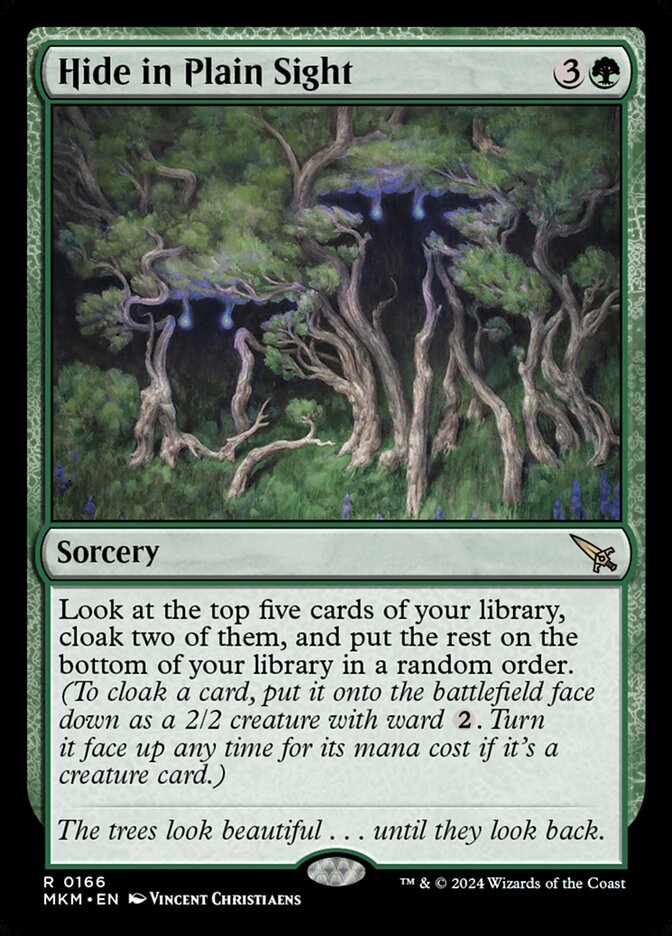
Cloak allows a card to be put face down on the battlefield as a 2/2 with Ward 2 (similar to Disguise). If the face down card is anything other than a creature, it’ll be stuck face down for the duration of the game. However, if it’s a creature, it can be turned face up at anytime for its mana cost - and if the creature happens to have Disguise, you can also flip it for its Disguise cost. Don't expect to run into this mechanic a ton, as there aren't many cards in MKM that use the mechanic, and the ones that do are almost all rares or mythic rares.
Suspect


Suspect is a strange little mechanic that allows you to place a marker on a creature labeling it as Suspected. When you do, it gains the upside ability of menace - and the downside ability of being unable to block. So is it good for your creature or bad? Well, it depends. Aggressive decks can take advantage of Repeat Offender's ability to Suspect itself to create an early evasive threat. On the other hand, Reasonable Doubt can be used on your creature or your opponent's creature, potentially neutralizing a creature as a blocker. This flexibility makes Suspect the rare aggressive mechanic that requires decision making, and that's pretty great!
Collect Evidence


When a card asks you to Collect Evidence X, you’ll be asked to exile any number of cards from your graveyard with total mana cost X or greater. Doing so gives you various effects depending upon the card: everything from a cost reduction for Bite Down on Crime to a tap effect for Forensic Researcher. These are powerful effects, but it's important to remember that Collect Evidence is far from free. A card can only be exiled from a graveyard once, and careful judgment must be applied in deciding when to do so - and when to wait.
Note that this mechanic also ties into one of themes of the set: cards that have a trigger when creatures exit your graveyard.
Cases

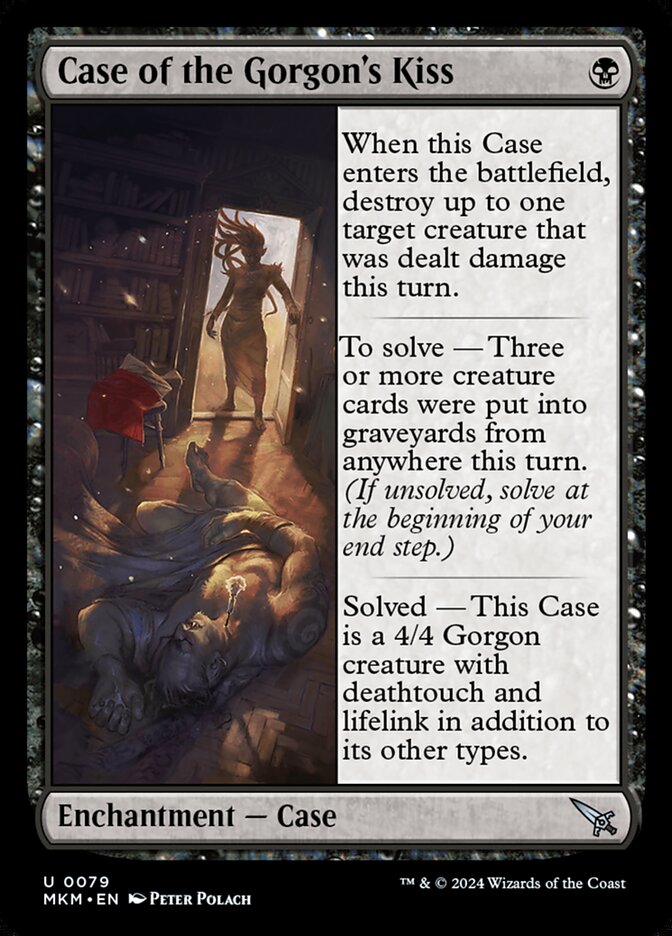
This new enchantment type shares a lot of similarities with Sagas: a vertical face and three segments of text. However, they work completely differently. When you cast a Case, you execute or gain the effect at the top of the card (for example, you'd Investigate with Case of the Filched Falcon). Next, your goal is to solve the Case by fulfilling the condition detailed by the middle block of text (marked by “To solve”) during your end step. Do so, and the card gains a reward: the bottom block of text marked “Solved”. This reward can vary from one-shot effects (Case of the Filched Falcon) to a new permanent (Case of the Gorgon's Kiss). Note that once a Case is Solved it will always remain Solved, even if the condition is no longer fulfilled.
Investigate / Clues


Investigate is a returning keyword that prompts a player to create a Clue: an artifact that can be sacrificed for two mana in order to draw a card. They can be created through a variety of effects - an instant like Deduce, or a hapless creature like Innocent Bystander. Clues are the hallowed ancestors of such popular artifact tokens as Blood or Food or Treasure, and serve as a similar glue mechanic that fits multiple themes: card draw, artifacts, and sacrifice.
Split Cards


A split card has two sides, each with its own card type and mana cost and. You can choose to cast one side or the other the removal effect of Push or the reanimation effect of Pull - but not both. In MKM split cards all use hybrid mana, allowing them to be cast in a wide variety of decks (for example, Push // Pull can be used in nine of the ten color pairs, with the exception being Green/Blue). These cards also add an additional wrinkle to the Collect Evidence mechanic, as the mana value of a split card in the graveyard is the sum of the mana cost of both halves of the card. That means [Hustle // Bustle] has a mana value of seven, single-handedly powering the most expensive Collective Evidence costs.
Archetypes
Unlike typical Ravnica sets, MKM features defined archetypes for all ten color pairs. Each of these color pairs have the typical signpost uncommon that exemplifies that archetype; however, there are additional cards in each color pair that bring some additional Ravnica flavor to the set.
White / Blue: Draw-Two Detectives

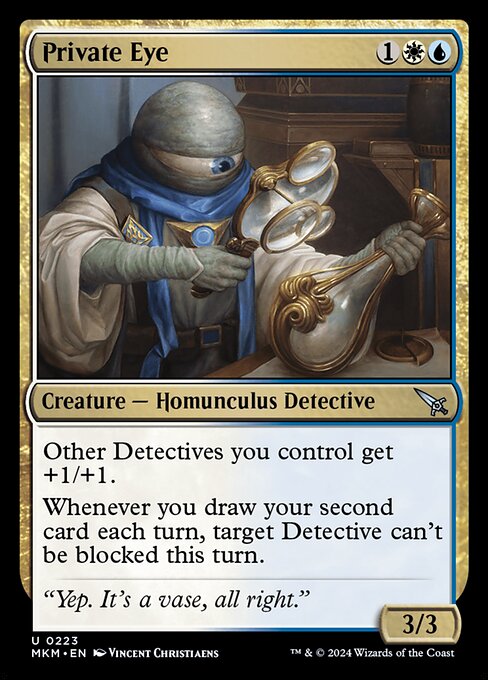

It’s pretty fitting that the Detective creature type is associated with the color pair of order and logic, with White/Blue's signpost uncommon buffing all these mystery solving sleuths. But is a simple creature type buff really Blue/White? Of course not, which is why there’s an additional twist: many Detectives get a buff from drawing two cards in a turn (most easily done with Clues). Do so, and cheap Detectives like Jaded Analyst turn into an attacking force to be reckoned with. And if you'd like to play a longer game, Case of the Pilfered Proof will make all your Detectives bigger while potentially providing you with important card advantage in later turns.
White / Black: Power 2 or Less



MKM is full of neat variations on traditional themes, and the White/Black archetype is one example. This color pair typically likes going wide, but instead of focusing on tokens this strategy focuses on creatures with power 2 or less (and note that Disguise creatures fall under this category). Wispdrinker Vampire exemplifies this idea by draining your opponent little by little, and allowing your little creatures to take out much bigger ones in the late game. That latter ability is very expensive however, and cards like Neighborhood Guardian and Slimy Dualleech give you lower cost ways to buff your creatures so they can attack.
Blue / Black: The Grind



It can be hard to seed a control archetype in a Limited format, since decks rely more on creatures and can’t consist solely on counterspells and removal spells and board wipes. Instead, Limited control archetypes tend to rely on being able to grind out value in order to outlast an opponent in the long game. That’s what a card like Curious Cadaver is for: an evasive threat that can act as cannon fodder while coming back again and again if your crack Clues in order to indulge in a control deck’s favorite activity: drawing cards. This is the color pair most likely to cobble together value out of the spare pieces no one else wants; for example, Agency Coroner will give you tremendous value if you combine it with Suspect cards. And in the long long long game, Living Conundrum will pretty much guarantee you victory - as long as you live long enough to draw your entire deck.
Blue / Red: Artifact Sacrifice
[Demand Answers] [Gleaming Geardrake] [Furtive Courier]
A player might see Gleaming Geardrake, think immediately of Lost Caverns of Ixalan’s Red/Blue uncommon - Captain Storm, Cosmium Raider - and conclude that MKM’s Red/Blue archetype is also about aggressive artifacts. That conclusion would be wrong: the most consistent method of sacrificing artifacts in MKM requires two mana, meaning you’ll be buffing Gleaming Geardrake far more slowly than Captain Storm buffed her army of pirates. What you do get with Gleaming Geardrake is value: built in card draw on an evasive body that will become increasingly threatening over time. Look for additional sacrifice outlets and payoffs as well: Demand Answers is a good outlet that also refills your hands; and Furtive Courier is a nice payoff that can loot you to the right card, or simply reduce your opponent's life total to zero.
Black / Red: Suspect
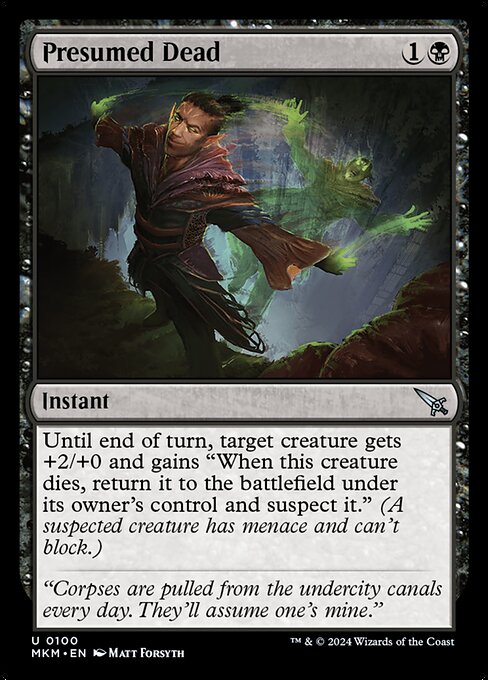

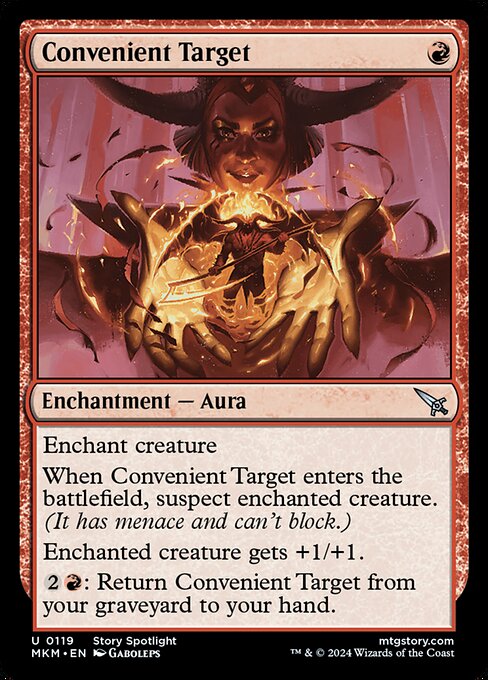
Past Rakdos mechanics have focused on aggression at any cost. Suspect is a neat variation on this idea, giving your creatures the unexpected capability to swing in early at the cost of being able to block. But how to make your creatures a Suspect? Runemark Juggler gives you one way to do so, while also turning your Suspects into effective removal. Presumed Dead is another one, and it has the added benefit of allowing you to bring back annoying creatures that may have been attacking headlong. And Convenient Target is a third: a cheap buff that can be cast again and again and again. By the way, note that this Aura doesn't say that you have to enchant one of your creatures. Turning your opponent's creatures into Suspects will be an excellent way to finish a game off.
Black / Green: Creatures Leave Graveyard



The Black/Green archetype sounds weirdly narrow while also being perfect for the Golgari colors. How often do creatures leave graveyards in a Limited game? Are there a plethora of reanimation effects in MKM? Well, there are some but not a lot - but remember that Collect Evidence also has the potential to uproot your dead creatures from their resting place. That’s what this archetype really is: self-mill plus Collect Evidence, with the rewards being value from cards like Insidious Roots: a stream of growing tokens that also allow you to ramp. And there are other cards that will trigger the "leave graveyard" effect when they die: Leering Onlooker is an amazing early game blocker that can turn into some useful bat tokens, while Rubblebelt Maverick is amazing at fueling your graveyard while giving you a nice little buff once it dies.
Red / White: Battalion Aggro

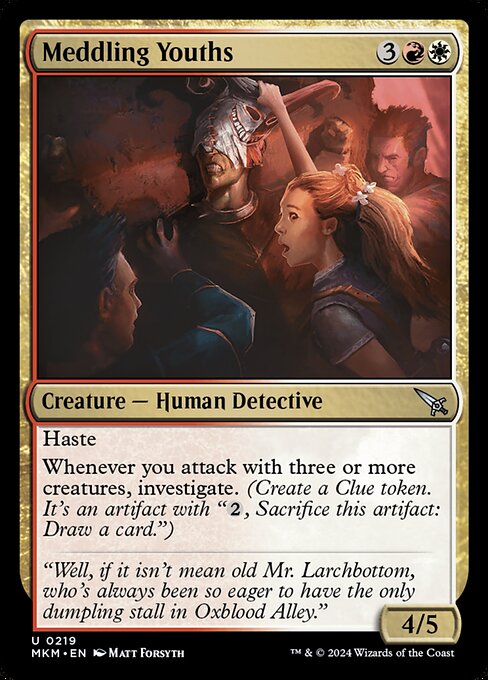

Red/White is almost always an aggressive archetype, which makes Meddling Youths a bit of an anomaly. The card’s Haste is certainly aggressive, but its five mana cost feels high in comparison to many other strong Red/White uncommons of recent sets. That’s because its key text is its ability to create clues when attacking with three or more creatures (a neat callback to the classic Boros Battalion keyword). Karlov Watchdog is another example of a creature with the implicit Battalion keyword, with its ability giving you a horrifyingly strong buff. This color pair also loves cards such as Person of Interest: a creature card that effectively gives you two creatures. None of these cards are cheap, but don't think of this as a midrange archetype; you'll still want plenty of cheap creatures and aggressive cards. But these are certainly effective ways to finish off a staggered opponent.
Red / Green: Disguise Midrange



Boom, crash, Gruul is here to smash. Red/Green’s archetype is exactly what you expect: play creatures that are bigger than your opponent’s creatures, and turn them sideways during your combat phase. The fun here comes with the Disguise mechanic: play a couple of face down creatures, and watch your opponent squirm as they try and figure out which one does two damage and which one will knock them out of the game. Tin Street Gossip is incredible here: a 4/4 creature for four mana that also has Vigilance, meaning it can attack and still use its ability to play or flip Disguise creatures. These Disguise creatures can provide more than just damage, with Culvert Ambusher allowing you to force an opponent's shy creature into combat. And if you're looking for real - and potentially devastating - value, Expose the Culprit has the potential to absolutely destroy the balance of the battlefield by flipping an expensive Disguise creature long before you have the actual mana to do so.
Green / White: Face-Down Creatures



One of Magic’s most traditionally straightforward color pairs gets a bit of an archetype twist that leans more into deception. Sumala Sentry clearly wants players to use Disguise and Cloak initially before turning those creatures face up for a buff. That flip will take a while to get going, so don’t expect to aggro your opponent out. However Tunnel Tipster will help accelerate the process while buffing itself if you play a face-down creature; and if you need to buy time then Essence of Antiquity will give you that while blanking a pesky removal spell or blowing out your opponent with some unexpected blockers.
Green / Blue: Collect Evidence



The archetype of ramp and +1/+1 counters gets to do something new in MKM. In this set, Green/Blue focuses on the Collect Evidence mechanic, with Evidence Examiner allowing you to Collect Evidence every turn in return for a Clue. That’s great value, but there are two things to note here. The first is that Collect Evidence has a cost, and one that must be paid anew each time. That means you need a way to fill your graveyard; Aftermath Analyst is a reasonable way to do so, and it even lets you retrieve your lands (which are useless for Collect Evidence) for some nice Ramp. The second is that Collect Evidence doesn’t win the game by itself. You need payoffs, such as the 1/1 Thopters provided by Surveillance Monitor. Built correctly, a Green/Blue deck will clog the board and grind out advantage bit by bit until victory is assured.
Key Commons and Uncommons
White
Creatures


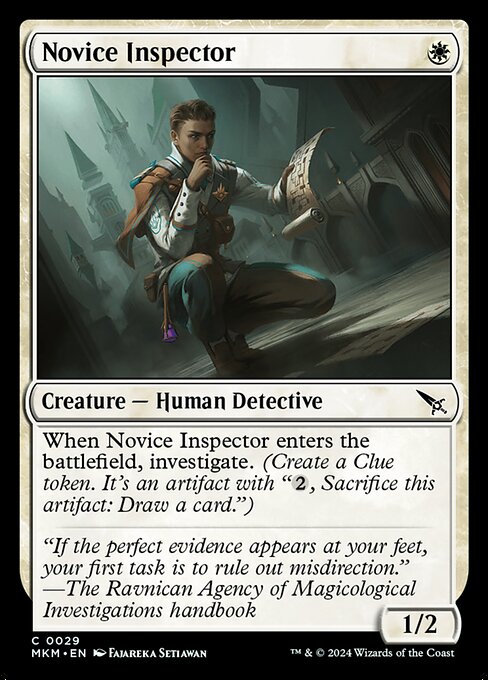
Inside Source: I don't think this creature's activated ability will make a huge splash (maybe if you have evasive Detectives). But if you have a deck that cares about attacking with three or more creatures or having "power 2 or less" creatures enter the battlefield, this card counts double.
Marketwatch Phantom: There are a couple of white creatures that seem really good in aggressive archetypes. I'm picking this one because I think a chain of these on successive turns will be one easy way to win.
Novice Inspector: One drops aren't always great. But this one has a beneficial creature type, synergizes with the "power 2 or less" theme, and creates a Clue for "draw two" or sacrifice synergies. I can't imagine a white deck that doesn't want this card.
Non-Creatures
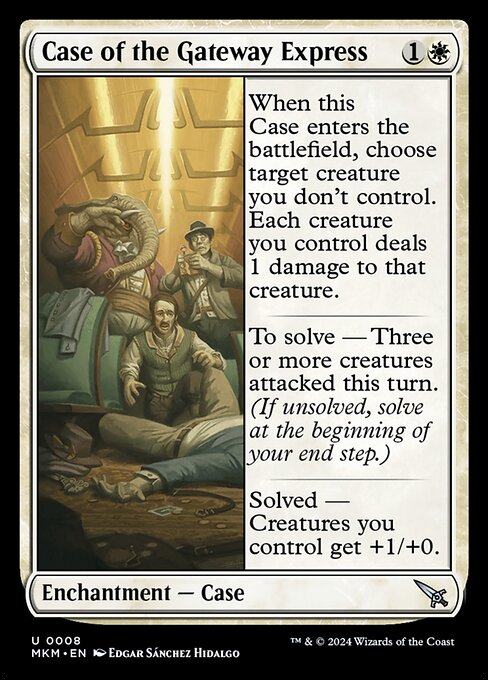

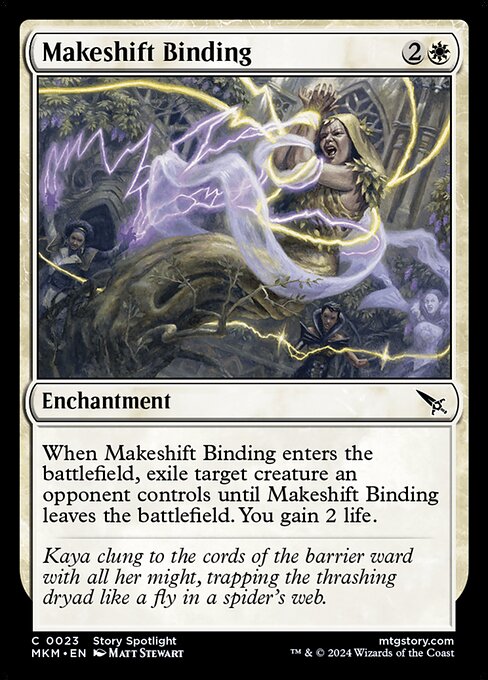
Case of the Gateway Express: This is a removal spell that can easily flip the turn you play it. Once it does, you'll get a permanent buff to your creatures, and all of that sounds very very nice.
Make Your Move: Removal spells with restricted targets are sometimes not great. But in MKM, battlefields will often be clogged with face-down 2/2 Disguise creatures, and in such a board state a 4 power creature is king. This spell snipes those would-be tyrants very efficiently, and has the upside of occasionally taking out an annoying Case.
Makeshift Binding: Unconditional creature removal, life gain, hooray!
Blue
Creatures



Cold Case Cracker: A four mana 3/3 flyer can win you the game, and if your opponent kills it then you'll still (probably) be able to draw a card
Exit Specialist: I don't know if the conditionally unblockable clause will often apply in a set with a plethora of face down 2/2s. But I do know that I'd happily pay 5 mana for a creature that bounces another creature, and this one has more flexibilty in regards to its mana expenditure.
Projektor Inspector: Looters are always insidiously great in Limited, and this one just asks you to play Detectives in a set chock full of them. The discard effect is even better in MKM, since it helps fuel Collect Evidence shenanigans.
Non-Creatures


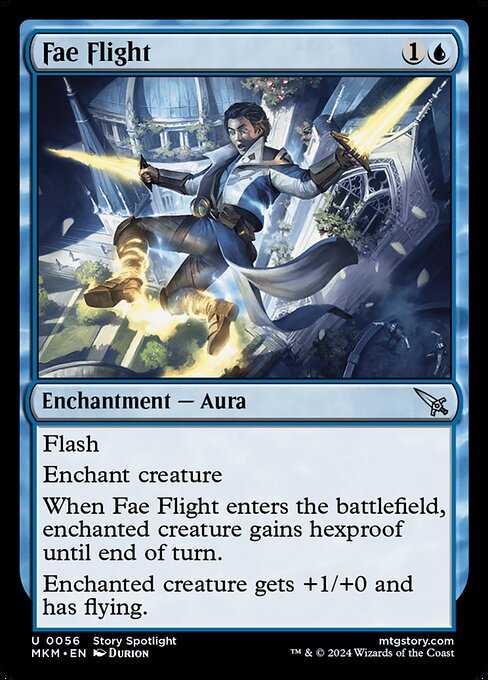
Dramatic Accusation: These Aura effects aren't my favorite form of "removal", but they definitely work. This one gets bonus points for being slightly more durable due to its instant speed shuffle clause.
Eliminate the Impossible: This card says a lot. I boil it down to: have your Disguised creatures. eat your opponent's Disguised creatures Then pay 2 mana later to draw a card. Oh, and randomly hose an aggressive Suspect deck. All of that sounds really good to me!
Fae Flight: This trick not only saves your best creature, it also turns it into an evasive threat. That combination is absolutely good enough to win games.
Black
Creatures


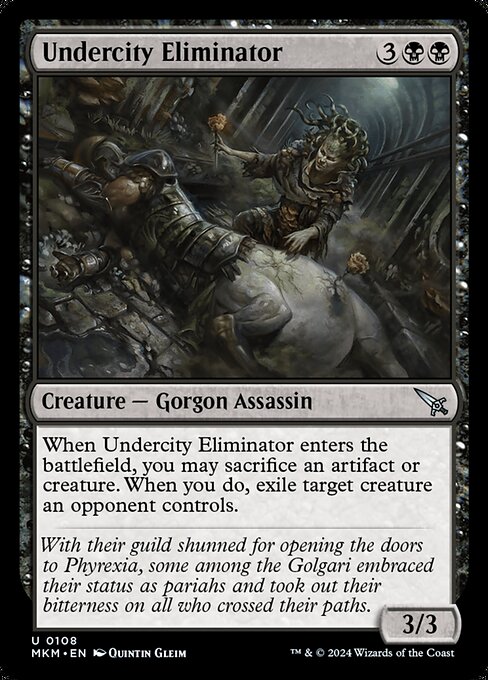
Clandestine Meddler: This creature simply works well with several archetypes - Suspect, Collect Evidence - and that makes it a safe pick for any Black deck.
Snarling Gorehound: This create simply works well with several archetypes - Aggro, Power 2 or Less, Collect Evidence - and that makes it a safe pick for any Black deck
Undercity Eliminator: In a set with Clue tokens, it should not be hard to ensure that this creature's effect works heavily in your favor.
Non-Creatures
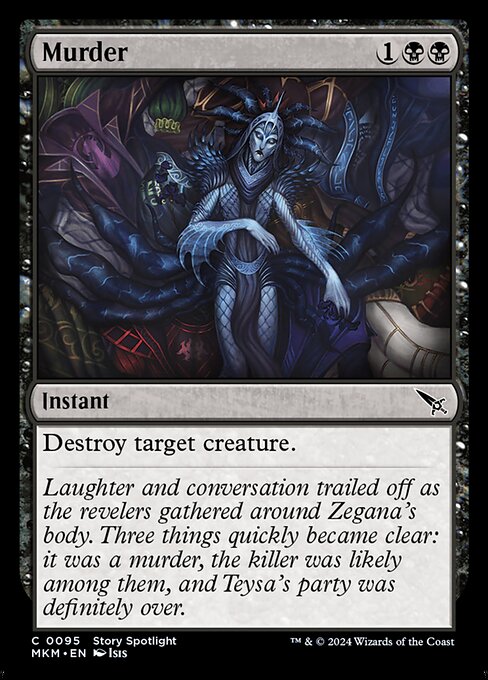


Murder: I mean, yeah.
Slice from the Shadow: Normally a card like this wouldn't be all that distinctive, since it's not particularly mana efficient for its effect. However the fact that it's an instant means you can use it as a combat trick; and the fact that it can't be countered means you can get around the Ward effect on Disguise creatures.
Soul Enervation: At first I thought this card was an Aura, which would make its drain effect laughable. But no; it's an enchantment that removes a creature, sits on your side, and slowly grinds out a game in your favor.
Red
Creatures



Cornered Crook: Sacrificing a Clue to deal three damage is not much of cost, and if you have any sacrifice synergies in play then this creature is simply nuts.
Harried Dronesmith: Sure, the Thopters don't stick around, but this creature provides a constant stream of sacrifice fodder (while also acting as a sacrifice outlet in a pinch).
Reckless Detective: It's strange to think of a 0/3 as a good card, and it's true that this creature is not great in a vacuum. But in the right deck this will be a reasonable source of card advantage or card filtering... and three toughness creatures are really good at blocking the plethora of 2/2s.
Non-Creatures



Case of the Burning Masks: Don't overlook a removal spell that has the potential to turn into card advantage.
Galvanize: Three damage for two mana (at instant speed) is great in Limited, even if you can only hit creatures. The flexibility to fry bigger fish makes this spell even better!
Torch the Witness: If you do the math, this isn't the most efficient removal spell, but it's also far from the least efficient - and if you also manage to create a Clue, then this is just straight up card advantage.
Green
Creatures


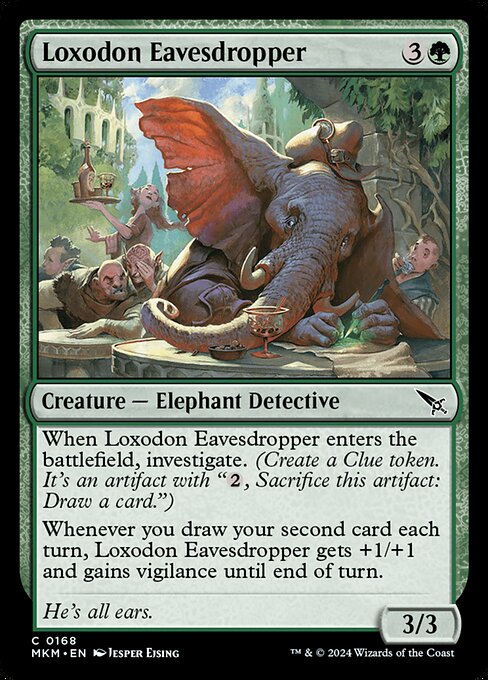
Glint Weaver: Green often has expensive creatures that gain you life... and they're often quite good. This one gets a bonus thumbs up since you have the option to buff another one of your creatures, potentially allowing you to swing in the turn you play this.
Greenbelt Radical: A 4/4 for four is fine, but if you Disguise this and then get to seven mana, you'll likely win the game on the spot.
Loxodon Eavesdropper: Would you play a four mana 3/3 that draws you a card? This isn't quite that, but it's not far off!
Non-Creatures



Case of the Trampled Garden: This Case will often let you win combat the turn you play it, and once it flips it’s a straight up engine for victory.
Fanatical Strength: I normally wouldn't rate a pump spell so highly. But the Ward clause on Disguise creatures means removal may be less effective than normal, and a combat trick may be the best way to win on the battlefield.
Hard-Hitting Question: If the question is whether a one mana bite effect is any good, the answer is definitely "yes".
Cards to Know
Mana Fixing
Here's the generic mana fixing:





Case of the Shattered Pact: No, really, it's okay to play this Case even if you'll never solve it.
Gravestone Strider: In this set, three toughness on a two drop is pretty good!
Escape Tunnel
Public Thoroughfare: Similar lands have been present in previous Limited formats without the option to tap an untapped artifact, and they've often felt very slow, preventing you from casting a spell for a turn. The option to type an artifact - most likely a Clue - makes this land much better.
Scene of the Crime: WEE-WOO WEE-WOO Be careful! This land is an artifact, and is hilariously vulnerable to artifact destruction effects.
There's also a cycle of rare dual lands, with all ten color pairs represented:
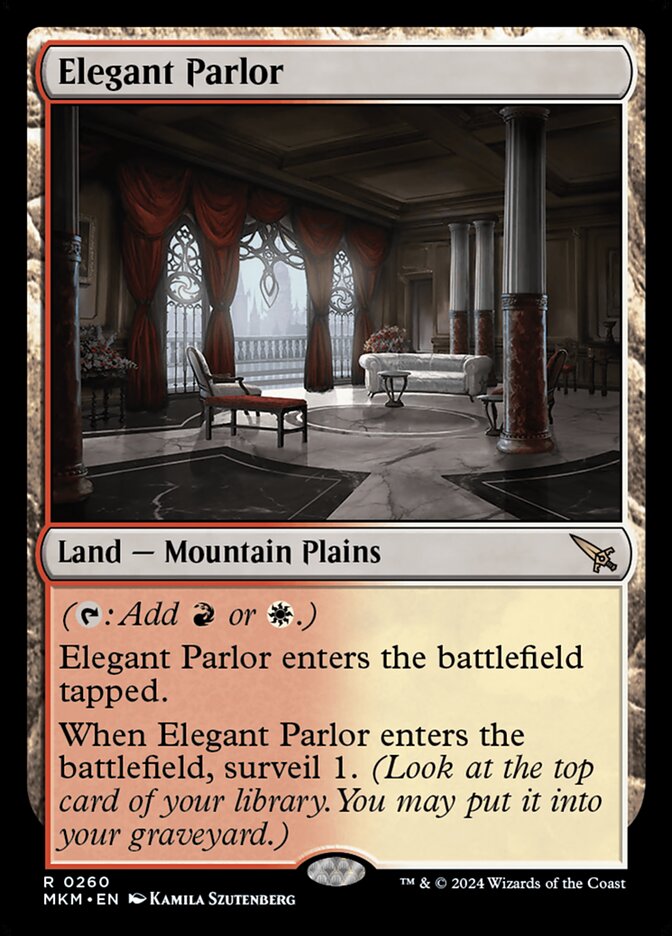

Notably, these rare lands are not found in the rare slot of an MKM booster; rather, 1 in 6 boosters will have one of these rare lands in its wildcard slot. That means an 8-man draft pod will typically have four of these dual lands floating around.
Of course, Green has additional mana fixing options:
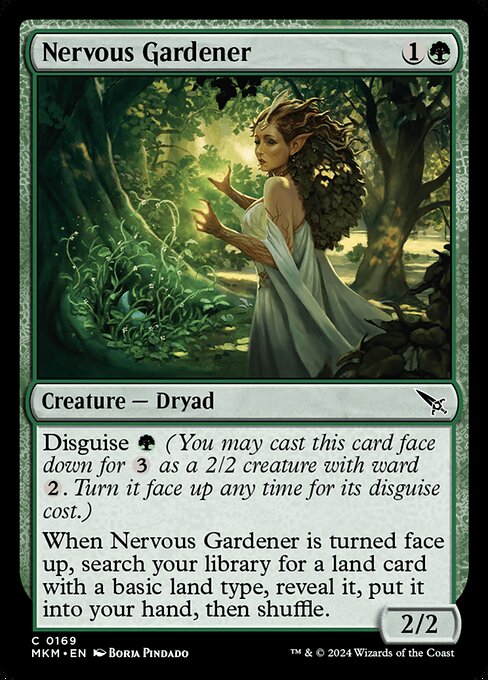


Nervous Gardener
They Went This Way
Topiary Panther: Bonus points for fueling Collect Evidence!
Reach
Forego this list of creatures with Reach at your peril:



Gearbane Orangutan
Glint Weaver
Vitu-Ghazi Inspector
Summation
So what are some key takeaways from this flood of information?
Remember: a face down creature with Disguise has Ward 2, making it slightly sturdier than you might expect. A two mana removal spell will cost four if you target a Disguise creature. Make sure you have the board presence to deal with a 2/2 by turn 3.
The Disguise mechanic also means that there will be a lot of 2/2s on the battlefield that are also resistant to removal. Cheap three toughness creatures will be excellent at blocking those.
A lot of mechanics in this set lean towards the slower side: Disguise, Collect Evidence, and Investigate to name a few. I think MKM will feel slower than other recent Limited sets.
That being said, there are also a fair number of aggressive creatures and strategies. Don't underestimate the power of an aggro deck, and don't neglect your two drops and early removal.
Creatures and spells that exile cards from an opponent's graveyard may be key in preventing a Collect Evidence deck from gaining excessive amount of value.
No, seriously, remember: a face down creature with Disguise has Ward 2.
Good luck!










